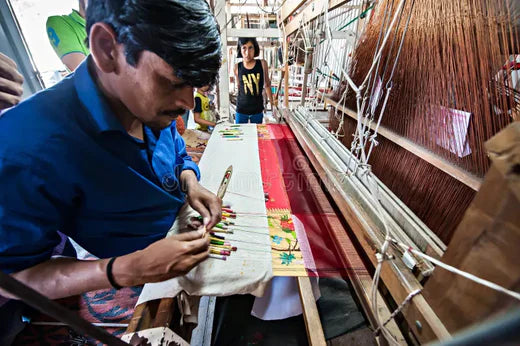A Day in the Life of a Paithani Weaver

Life of a Paithani Weaver
The creation of a Paithani saree is a labor of love, dedication, and unmatched craftsmanship. Behind every exquisite piece lies the relentless effort of skilled artisans who devote their lives to preserving this centuries-old tradition. Let’s step into the daily routine of a Paithani weaver to understand their journey in crafting these timeless masterpieces.
1. Morning: Preparing for the Day
-
Early Start: A Paithani weaver’s day often begins at sunrise, reflecting their disciplined lifestyle. After a light meal, they head to their workshop, which is often part of their home.
-
Organizing Materials: The day starts with organizing silk threads, zari, and other tools needed for the day’s weaving. Careful attention is given to ensure the materials are of the finest quality.
2. Setting the Loom
-
Loom Maintenance: Before weaving begins, the loom is inspected and adjusted to ensure smooth operation. Traditional handlooms, used for Paithani weaving, require regular care.
-
Warp and Weft Preparation: The silk threads are meticulously arranged on the loom. This involves precision and patience, as even a minor error can affect the final design.
3. Mid-Morning: Weaving Begins
-
Focus on Intricate Patterns: The weaver begins by working on the intricate borders or motifs. This requires intense concentration as each thread is handwoven to achieve the desired pattern.
-
Motif Creation: Using a tapestry weaving technique, the weaver crafts signature Paithani motifs like peacocks, lotuses, and creepers. Each motif can take hours or even days to complete.
4. Afternoon: A Break for Nourishment
-
Lunch and Rest: The weaver takes a break for a simple home-cooked meal, often shared with family members. This time is also used to rest the eyes and hands, which endure the strain of meticulous work.
-
Revisiting the Progress: After lunch, the weaver inspects the progress made so far, ensuring that the design aligns with the planned pattern.
5. Afternoon: Resuming the Craft
-
Detailing the Pallu: The pallu, the most decorative part of a Paithani saree, is the focus of the afternoon. The use of zari threads to create shimmering designs requires steady hands and immense skill.
-
Problem Solving: Any inconsistencies or issues in the weave are addressed promptly. Weaving is a meticulous process, and corrections are made on the spot to maintain perfection.
6. Evening: Wrapping Up the Day
-
Reviewing the Day’s Work: As the sun sets, the weaver reviews the day’s progress. The loom is carefully covered to protect the silk threads from dust or damage.
-
Recording Details: Some weavers maintain notes or sketches of the designs, ensuring continuity in the next day’s work.
7. Evening Relaxation
-
Spending Time with Family: The evening is often spent with family, sharing stories and discussing the craft. For many, weaving is a family tradition passed down through generations.
-
Cultural Connection: Many weavers find inspiration in local festivals, rituals, and nature, which influence the motifs and patterns of their work.
8. Challenges Faced
-
Physical Strain: Weaving requires prolonged sitting and repetitive hand movements, which can lead to fatigue.
-
Economic Pressure: Despite the high value of Paithani sarees, weavers often face financial challenges due to the time-intensive nature of the craft.
-
Preserving Tradition: Weavers are also custodians of heritage, striving to keep this ancient art alive amidst changing fashion trends and market demands.
A day in the life of a Paithani weaver is a blend of dedication, artistry, and resilience. Each thread they weave carries a story of heritage, passion, and perseverance. By understanding their daily routine, we can better appreciate the effort and skill that go into creating a Paithani saree, making it not just a garment but a piece of living history.
